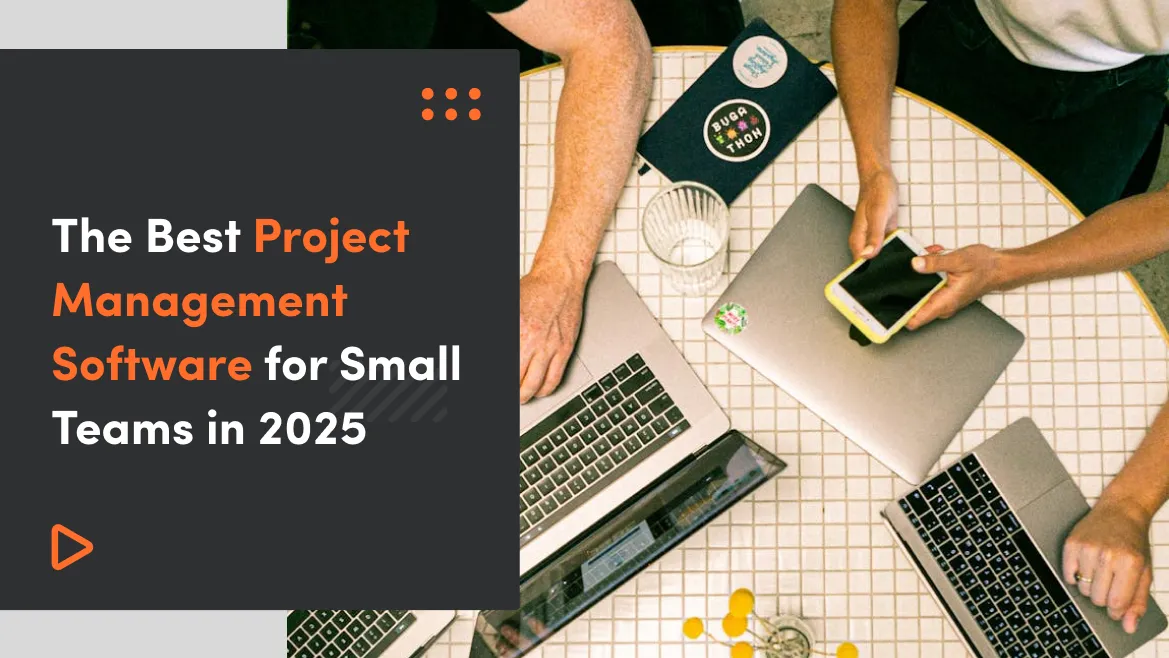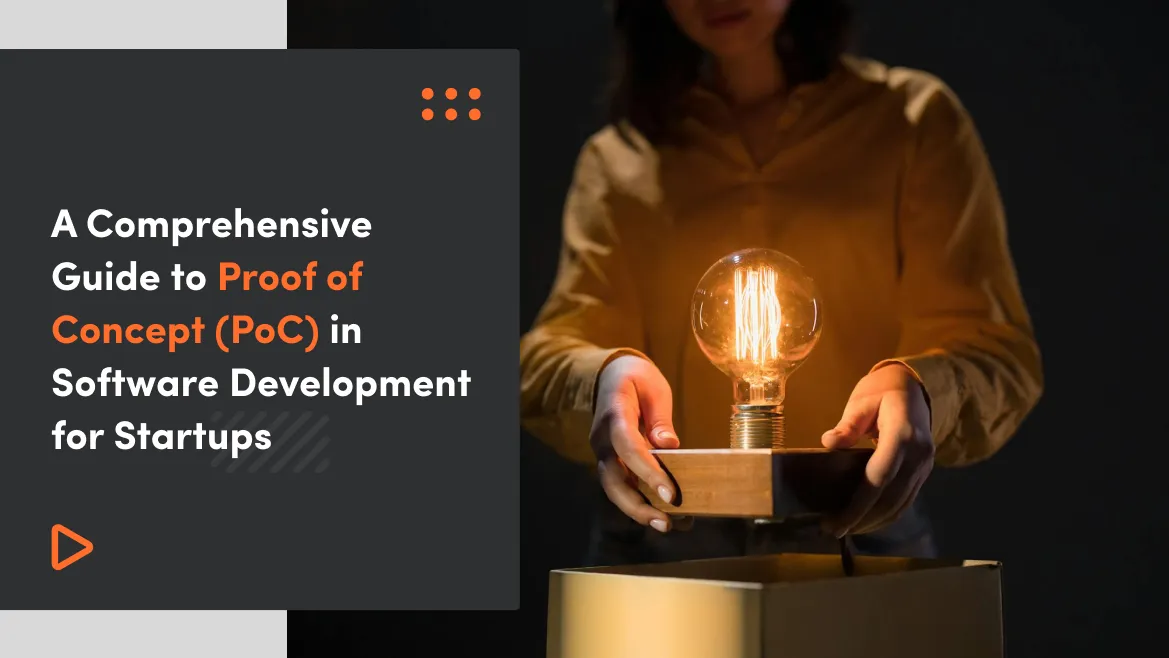Building a learning management system from scratch can seem hard, but the idea is simple. Turn clear learning goals, content and users into one place that supports real progress. This guide shows the path from first idea and MVP to tech stack, rollout and long term growth. It helps you decide when a custom LMS beats ready SaaS tools. You can then grow learning step by step instead of guessing.
-
Clear business goals and target learners guide every LMS project decision, from features to budget.
-
Choosing SaaS, open-source or a custom own learning management system changes cost, control and speed.
-
Start with a focused MVP and then grow the LMS solution using real user feedback and learning data.
-
A solid tech stack, clean data and steady process with QA help mitigate risks and keep development time under control.
-
A well designed custom LMS becomes a long-term competitive advantage, not just another internal tool.
What Is an LMS and How Learning Management Systems Support Modern eLearning & Employee Training?
A learning management system, or LMS, is software that helps an organisation deliver, track, and measure training in one place. You can think of an LMS platform as a simple home for courses, people, and results. An LMS system manages access, stores progress, and keeps learning organised. User management in an LMS involves creating and managing user accounts with role-based permissions. This makes learning management clear and easy to improve over time.
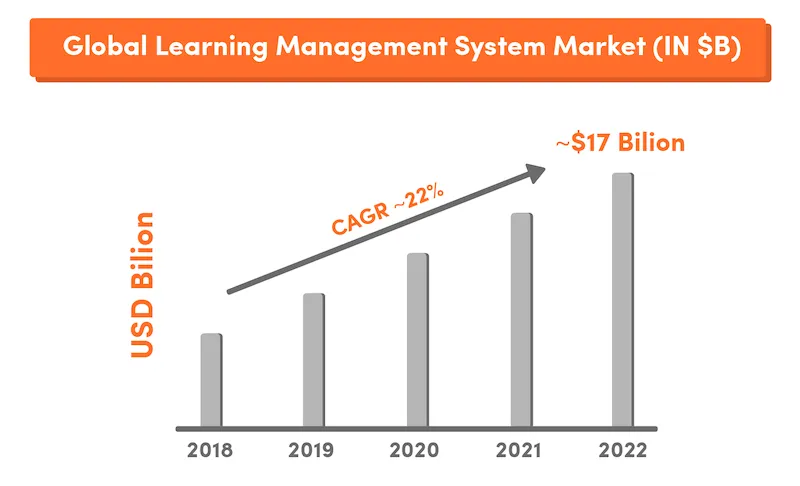
Learning management systems support many forms of online learning. They group educational content and training materials so people can study at their own pace. HR and L&D teams use such a system to plan corporate training and employee training, see who finished lessons, and spot areas that need attention. The same LMS solution also supports online education and distance learning across many locations. One learning environment means one view of the whole learning process. The global market for corporate learning management systems was valued at $9.98 billion in 2023 and is projected to reach approximately $63.12 billion by 2033.
These systems appear in onboarding, compliance, product training, and customer training. In each case, the LMS connects a business goal with a target audience and shows real learner progress. According to recent reports, the global learning management system market keeps growing as more organisations move training online. This shift reflects the rise of e learning and the need to understand how people learn, not only what they receive.
Over time, many teams find that simple tools no longer fit their work. They may need better reporting, secure access, or links to HR systems. When common platforms cannot support real processes, it can make sense to build an own learning management system shaped around those needs. Some organisations turn to partners experienced in E-learning software development to create such a system. This step turns the LMS idea into a long-term part of the business and not only a place to host courses.
Types of Learning Management Systems and Deployment Models
Learning management systems come in a few main forms. The most common deployment model is a cloud service, often called SaaS, but you also see installed systems on your own servers, open-source tools and fully custom builds. Each type of LMS solution balances cost, control and effort in a different way. When you plan an LMS project, it helps to know these options before you decide how deep you want to go with your own learning management system. This choice shapes later work more than many teams expect.
One way to look at these management systems is to group them by how fast you can start and how much you can change. A hosted tool in the cloud can feel like a simple LMS, ready for basic online learning with little setup. An installed system on your own hardware needs more care from your IT team but gives more control over data and setup. Open-source tools sit in the middle, because they lower licence cost but need people who can change the code. You can see how different ready-made tools approach this mix in the Top 10 Best LMS Platforms overview.
Read also: How To Start An EdTech Company Or Startup
From my own experience, the best fit depends on business needs and on who will use the system. A small team with a clear target audience may be happy with a simple LMS that supports basic corporate learning and a few online courses. A large organisation with many brands, complex rules and strict security often cannot rely on one standard elearning platform. At some point an own LMS becomes a better choice because it reflects how the company already works. That is why some teams talk about their LMS as part of the core business rather than a side tool.
Key differences between popular LMS deployment models:
- SaaS LMS → fastest launch, lower upfront cost, limited deep customisation
- Open-source LMS → no licence fees, flexible codebase, requires strong internal tech skills
- Custom LMS → full control over features and data, best long-term fit, highest initial investment
The deployment model also affects later work on features, links to other systems and long term cost. A hosted tool often hides the technical side, while a custom or installed system needs more planning around security and updates. A custom deployment can match existing systems for HR or finance, while a cloud option can keep the setup lighter for a small LMS project. Some organisations like to use partners with SaaS development services experience when they want a cloud platform that still feels like their own learning management system. In each case the choice shapes how fast you move and how much you can change in the future.
SaaS vs Installed LMS — Choosing the Right Learning Management Model
A SaaS LMS is a system you use over the internet. An installed LMS is software that runs on your own servers. A SaaS LMS keeps upfront cost and daily care low, while an installed LMS gives more control but needs more work. With SaaS you pay a subscription and the vendor runs updates and fixes. With an installed system your own IT security team looks after the setup and the hardware. This basic choice is the heart of the deployment model decision.
For corporate learning the difference shows up in simple ways. A SaaS LMS lets a team start fast and test ideas with less effort. An installed LMS fits better when business needs around data control and strict rules are very strong. For example some banks or public bodies like to keep learning data inside their own data centre. A SaaS LMS vendor can still offer good security but the data sits in the vendor cloud. Each option can support the same courses and users but the risk profile feels different.
Cost also follows this pattern. A SaaS system spreads cost into a steady monthly fee. An installed LMS often needs a larger project at the start and more work from internal teams. A good rule is that SaaS helps when you want lower cost now and installed helps when you want more control later. That control includes how updates happen and when the system goes down for planned work. For some teams this control matters more than the extra effort.
Open-Source vs Commercial Learning Management Systems
An open-source LMS is a system where the code is open to view and change. A commercial LMS is a system sold as a paid product by a vendor. Open-source tools cut licence fees but need more skills and time, while commercial tools cost more money but less effort. In open-source you often pay with hours of work instead of subscription bills. In commercial tools you pay for the right to use the system and for ready support. Both paths can lead to solid LMS development.
Open-source examples include Moodle and similar systems. Anyone can download the code and set it up. Teams can change features in an open-source LMS if they have people who know how to code and test those changes. This allows very specific custom functionality and deep fit with local rules. It also means you need development teams, QA engineers and often DevOps staff. Without them the system can stay basic or become hard to maintain.
Commercial learning management systems work in a different way. The vendor controls the code and ships ready releases. You trade control over the code for a stable product, a known feature set and planned updates. This can be enough when your management system development needs match the vendor roadmap. The cost shows up as regular fees and add ons. For some organisations this is fine because they value speed and predictability more than deep custom change.
Integrated vs Standalone LMS Platforms
An integrated LMS connects with other systems in your organisation. A standalone LMS works on its own and keeps all data inside the tool. An integrated LMS becomes part of a wider learning and people stack, while a standalone LMS stays simple and self contained. The choice affects both daily use and long term reporting. It also shapes how customer training and internal courses appear in other tools.
Common integrations include links to HRIS, CRM and tools for single sign on. In an integrated LMS people can log in with the same details they use for mail or other work apps. Course data can flow back into HRIS and show up in manager reports. This makes the LMS a single source of truth for learning records instead of an isolated island. It can also help when audits or compliance checks need proof of training. The value shows up the most in larger organisations.
A standalone LMS avoids this extra work. It stores accounts, courses and results inside one system. For a small team or a simple lms project a standalone setup can be easier to start and easier to run. You do not need to think about complex integrations or shared user data. This can be enough when you just want to host a few courses and see who finished them. The tool stays focused and light.
Custom LMS vs SaaS LMS vs Open-Source LMS
Try our developers.
Free for 2 weeks.
No risk. Just results. Get a feel for our process, speed, and quality — work with our developers for a trial sprint and see why global companies choose Selleo.
Must-Have Custom LMS Features for Scalable Learning Management and Better Learning Experience
The must-have LMS features are simple to name. A real platform needs user management, course and content management, assessments and clear reporting as its core features. These elements form the base of all learning management system requirements and help teams guide the learning process with structure and clarity. Compliance with e-learning standards like SCORM or xAPI is important for LMS content interoperability. Without them even a nice layout cannot support real learner progress.
Essential LMS features that support real learning at scale:
- User and role management with clear permissions
- Course and content management built for frequent updates
- Assessments, quizzes and automated tracking
- Reporting dashboards for learner activity and outcomes
- Support for SCORM/xAPI for content interoperability
The core work starts with people and content. User management and the way you create courses shape everything that follows. A good system makes it easy to create content, reuse existing content and add new materials at any time. It should also handle educational content in many forms, from short learning materials to deeper training materials. Simple content authoring tools help teams build each particular course with less effort.
Daily learning needs tools that keep people active. Strong lms features support a stable learning environment where teams can track progress, share user feedback and keep engagement high. Small touches like discussion boards or comments help learning feel shared, not lonely. These features support a better learning experience for many types of users.
Growth also matters. An LMS should support multiple languages, mobile use and only add advanced features when they bring clear value. This matches ideas from the article 5 key features for LMS platforms, where the focus is on essentials that scale well. A steady base makes learning easier for teams and for the people who use the system each day.
Course & Content Management: Core Features for Effective eLearning Delivery
Strong course and content management helps teams create courses, reuse existing content and keep all learning materials in order. A clear structure for course content is the base of effective eLearning delivery. A good LMS should handle many types of educational content, including videos, PDFs and SCORM packages. It should also support training materials that change often and need simple updates. Well organised modules make each particular course easy to follow.
From my own experience, a simple library is not enough. Teams need tools that let them create content fast and adjust it without waiting for developers. Good content authoring tools help build lessons in small steps. Versioning, search and tags keep new materials easy to find. These details help large sets of learning materials stay clear even after years of work. They also help when many people build courses at the same time.
Another helpful part is the ability to reuse existing content. Most teams save time by copying short parts of older courses into new ones. An LMS should make this simple. It should also guide the user through modules in the right order. These steps keep educational content clear for people who are new to the topic. They also help course owners get better results with less effort.
Skill Tracking for Personalized Learning Experience and AI-Driven Progress Insights
Skill tracking links learner progress to clear skills. It gives a simple way to track progress and build a more personal learning experience. Each skill can match a task or role in the organisation. People see where they stand and what they can learn next. Managers can spot gaps faster with this view.
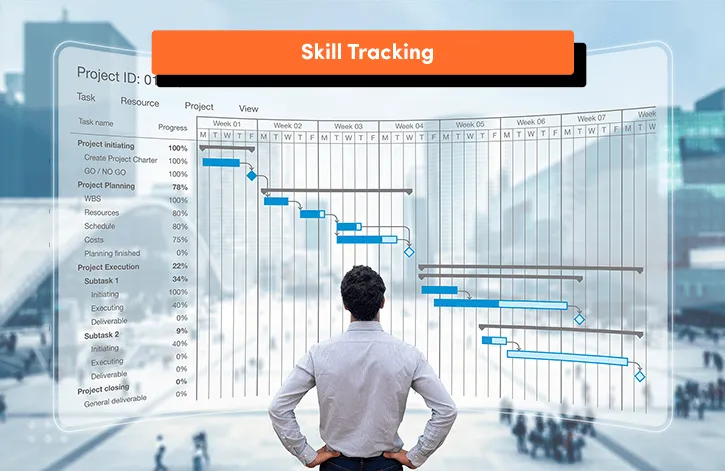
Once skills are clear, artificial intelligence can help. AI can suggest new lessons based on the skills someone used or missed in past courses. These suggestions feel simple but make a big change. They help learners move at their own pace. They also help the system adjust when roles change.
Skill tracking also supports teams outside learning. Reports can link skills to jobs in the HRIS and show how people grow over time. This helps leaders plan training for whole groups. It also helps them pick the right training path for each person. A good skill matrix grows with the team.
Analytics, Achievements, Statistics & Surveys: Data-Backed Learning Management
Analytics turn an LMS into a real learning management tool. Without analytics an LMS is only a library, but with dashboards it becomes a data-backed learning environment. A few metrics tell most of the story. Completion rate shows who reached the end. Time to complete shows how hard a course feels. Quiz scores show where people struggle.
Surveys add the human view. User feedback shares what worked and what did not, and often shows issues hidden in numbers. A simple form after a course can guide many improvements. It also helps teams test new ideas. With surveys teams see what makes content clear and what needs more work.
These data points help with business goals. Good reports can show risks early and help teams mitigate risks before they spread. A clear dashboard helps spot compliance gaps. Managers can then assign courses to close those gaps. This step protects both people and the organisation.
Gamification Features That Boost Engagement in Custom LMS Development
Gamification adds small game-like elements to learning. Points, badges and leaderboards make the learning experience more fun and raise engagement. These simple touches can turn hard lessons into small wins. To improve engagement, gamification elements such as points, badges, and leaderboards can be integrated into the LMS. They help people return to the course and try again. Many teams find that even a few points help people stay active.
I have seen how gamification changes the mood in groups. Learners try to pass the next level to stay ahead, not just to finish. This kind of energy helps many teams, especially when topics feel dry. Badges can show skill growth. Leaderboards can push friendly competition. Each tool helps in a different way.
Gamification is an advanced feature. It works best after the core features of the LMS are solid and stable. Many teams add it after early feedback. This avoids confusion and keeps focus on the basics first. When done well it supports learner progress without making things complex.
Social Structure: Collaborative Learning Experience Inside Learning Management Systems
Social structure gives people ways to learn together. Discussion boards, comments and peer feedback turn an LMS into a collaborative learning environment. This helps people feel part of a group. It also makes learning less lonely. Many teams find that group talk makes ideas clearer.
There are many forms of social learning. Forums work well for longer thoughts and structured chats. Comments help with quick notes or questions. Some teams use peer review to share work. These tools help new people feel safe. They also help experts share tips. The effect shows up fast in course results.
Social tools need basic rules. Clear moderation keeps talks helpful and safe for all users. Good governance helps groups work well. It also helps avoid noise that hides the real ideas. In some cases, like onboarding cohorts, social learning is a must. It builds trust and makes early progress easier.
Mobile Learning as a Critical Element of Modern eLearning Platforms
Mobile learning gives people access to courses anywhere. A mobile-ready LMS helps people access courses when they have time, not only at a desk. This matters for field teams, shops and sites. It also helps people who learn in short breaks. A mobile view makes this flow natural.

There are two main options. A responsive UI adjusts to the phone screen. A native app adds richer tools. Native apps can send push notifications and support offline mode when the internet is weak. These tools help people keep learning even in busy places. They also support micro-learning with short lessons.
Mobile tools can shape the whole elearning platform. Teams can use them to share updates or new lessons fast and keep users active. For some groups this is the only way to reach them. It also links well to the idea of custom setups. A partner with custom mobile app development skills can bring LMS features to the phone.
Development Process: How to Create a Learning Management System From Scratch?
Creating a learning management system starts on a clear plan. You follow a full development process that turns an early lms idea into a working product. This approach keeps the work close to real business goals and gives structure to each step of lms development. A comprehensive discovery phase is necessary for successful learning management system development, which includes understanding market needs and setting wireframes.
The first phase is discovery and business analysis. Business analysts and a project manager shape needs into simple user stories. This work defines what the lms project must support and which tech stack fits best. Clear analysis at this stage reduces risks later and speeds up management system development.
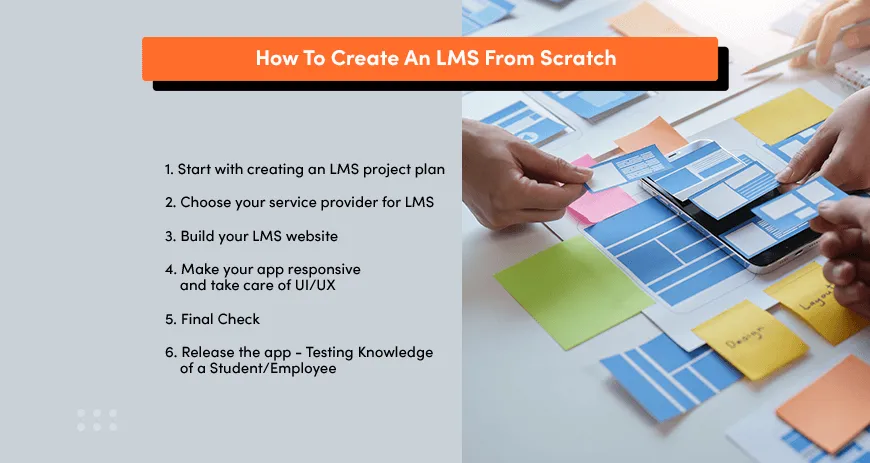
Teams then build a minimum viable product. An MVP tests the core flows before the product grows in size. Development teams keep development time short and focus on what matters most. Creating a minimum viable product (MVP) is recommended for learning management system development to test core functionalities and gather user feedback. This step helps mitigate risks because real users try features early. It also shows which parts of custom lms development need more work.
The final phase focuses on quality. QA engineers use automated tests to keep each change safe and stable. This makes lms development predictable over many releases. A process like this is common when working with a custom LMS development company, as it keeps progress steady from design to rollout.
Step #1: Create an LMS Project Plan Aligned With Your Business Model
Your lms project begins with a clear plan. You define the business model, target audience and business goals before you write any code. This early work shapes the whole lms idea. A business analyst helps turn broad needs into simple steps. Teams then map the learning process and check which learning materials and existing content will move into the new system.
Clear goals guide every later choice. You set success metrics so you know what “working well” means for your team. This can include faster onboarding or better reporting. The target audience also matters, because employees, partners and customers learn in different ways. A short business analysis phase gives structure and turns early doubts into a stable plan.
Planning also helps reduce confusion. You capture who learns, what they learn and why it matters to your business model. This gives the lms project a shared direction. HR and IT join this phase to align rules and expectations. This makes later work easier because each group knows its role from day one.
Step #2: Choose a Service Provider Specializing in Learning Management System Development
The right team makes management system development safer. Strong development teams have LMS examples, clear communication and a stable process. They show how they work and share real case studies. This helps you see how they solve problems and mitigate risks.
Good partners bring more than code. They explain their tech stack and show how they support quality over time. A custom LMS development company often shares its RFP notes and references. Talking with business analysts and a project manager helps you check if the team understands your goals. That early talk removes many blind spots.
Security and clarity also matter. Teams that handle IP ownership, open documentation and safe workflows keep work transparent. This makes management system development predictable. It also creates trust between everyone involved.
Step #3: Build Your LMS Website and Define Core Features for Custom LMS
The build starts small. Most teams design a minimum viable product that shows the core features first. This includes user management, course management and simple reporting. A clear backlog helps you pick what goes into the first version.
Keeping scope small speeds up progress. You add essential features first and wait with advanced features until the base works well. This protects the project and reduces rework. Even a simple lms can answer early questions about flow and structure.
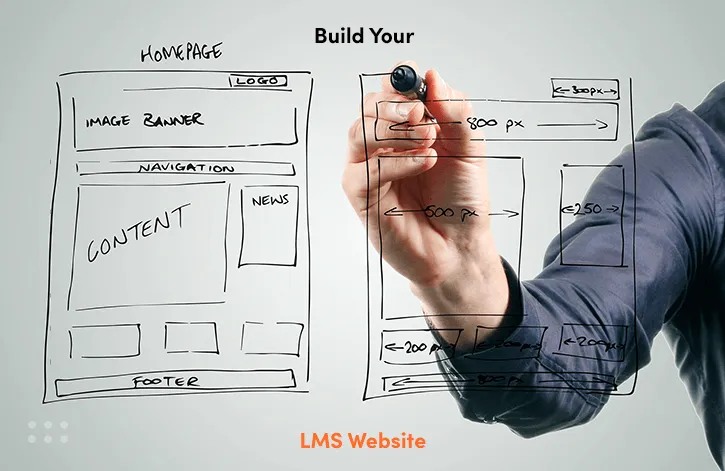
Integrations appear later. Teams often prepare the first links to SSO or HRIS only when the MVP is ready. This keeps work focused on learning, not complex extras. Custom functionality grows from real use, not guesswork.
Step #4: Make Your App Responsive and Design a User-Centric Learning Experience (UX/UI)
A clear view helps people learn. Good UX makes the learning process simple and pleasant for everyone. Learners should find what they need without stress. This often means short paths and simple choices.
A design system keeps things consistent. Reusable UI elements build trust and speed up work. A UX designer shapes these parts and tests them with users. Smooth funnels then replace guesswork.
Accessibility matters for all teams. Your user interface should support multiple languages and common rules like WCAG. This ensures more people can use the LMS. A helpful note on this comes from our web design company, which studies how design impacts learning.
Step #5: Final Check — Validate Features, Content Structure and AI-Readiness
Testing protects the project. QA engineers use automated tests and manual checks to spot issues early. They run many simple scenarios to see how the LMS behaves under load. The development process for an LMS must include thorough testing, including functionality, performance, and security testing. This reduces surprises later.
Validation covers more than bugs. Teams test the learning flow, reporting and content structure to make sure everything works together. They also check how fast the system responds. These steps often show small gaps that matter a lot. User testing is a critical step in the development of a learning management system, as it helps identify usability issues and improve the user experience.
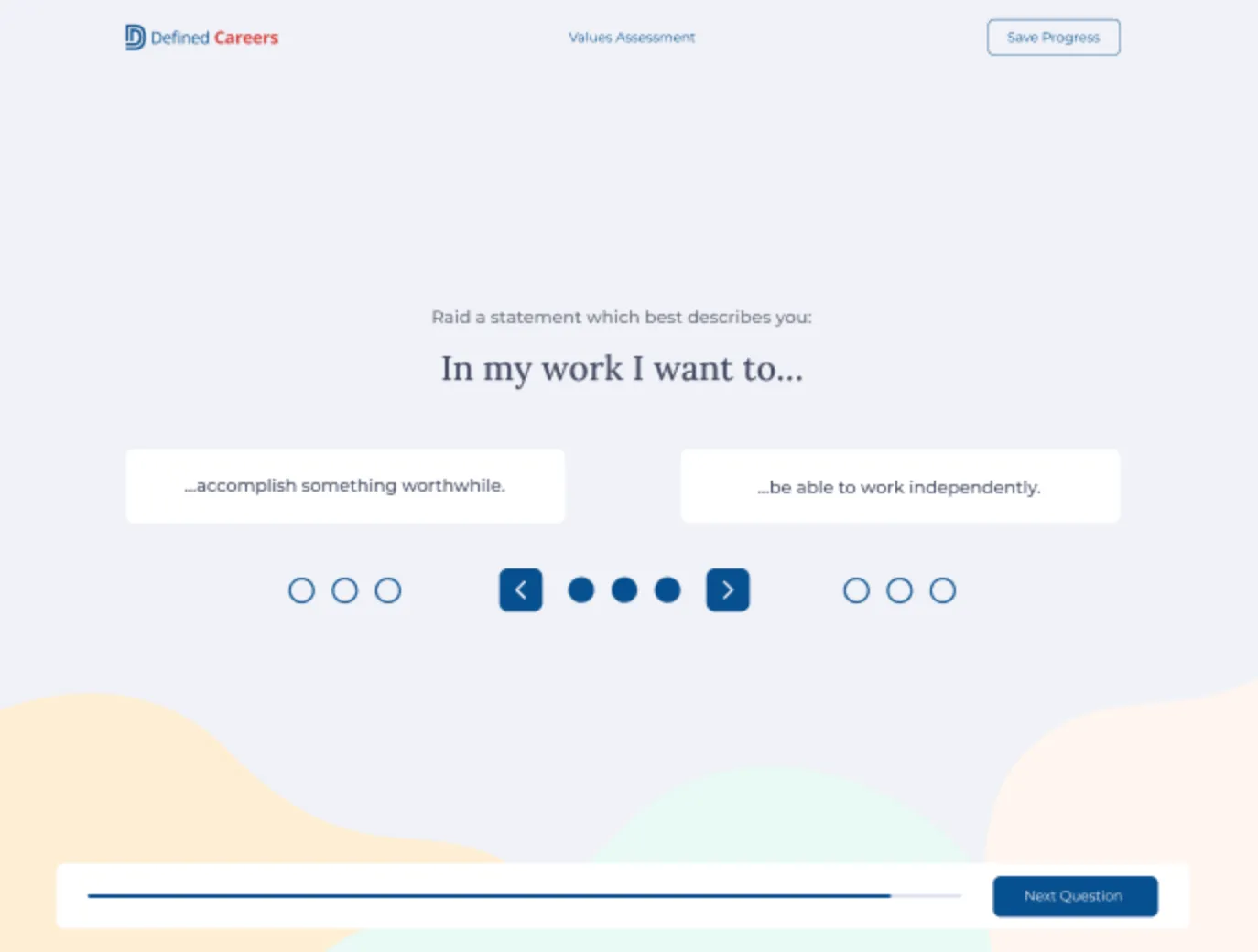
Clean data supports future features. AI tools need clear records of learner progress to work well. This makes structured content an important aspect of every lms project. Careful testing helps mitigate risks before launch.
Step #6: Release the App — Testing Knowledge and Improving Employee Training Outcomes
A careful rollout helps people adjust. Teams release the LMS in waves and check early reactions. A small pilot group tries the system first. This gives honest user feedback and real training outcomes. Continuous monitoring and feedback collection are crucial for maintaining and improving the LMS post-launch.
Clear data guides change. Metrics like completion and satisfaction show what works and what needs attention. These numbers make it easier to improve content. Real employee training sessions then confirm progress.
Feedback keeps the LMS alive. Teams add new training materials based on questions from daily use. This builds a helpful loop between users and creators. Over time the learning process becomes more natural and effective.
Technology Stack and Architecture for Custom LMS Development
A solid tech stack is the base of every strong LMS. Most custom LMS platforms use a modern web stack with a clear lms backend, resilient database and cloud hosting. The frontend handles the learner’s daily work. The backend runs the logic of your management system development and integrations. Choices here also depend on the deployment model and long-term business risk.
On the backend, teams often choose Node, Python or Ruby on Rails for the main lms backend. On the frontend, React or similar tools help create a clean, fast interface that fits a reusable design system. We treat LMS as any other complex product inside our custom software development practice. This means early decisions on data flow, security rules and how to plug in custom functionality later. Clear structure here makes future work much easier.
Core architectural decisions that shape a scalable LMS:
- Choice of backend framework and API design
- Database model structured for analytics and reporting
- Hosting and scaling strategy (cloud, multi-tenant, dedicated)
- Integration approach for HRIS, CRM and payments
- Future readiness for AI-driven recommendations and personalisation
Data and hosting sit under everything. Relational databases like PostgreSQL store course data, user states and reports in a safe and predictable way. Cloud platforms such as AWS then host the app and handle scaling. Our DevOps services cover CI/CD, monitoring and backup so the system can grow without chaos. This setup cuts development time and helps mitigate risks linked to outages and errors.
Architecture also shapes advanced features. If the LMS is built cleanly, teams can later add artificial intelligence for recommendations or smarter search without a full rewrite. Clear module borders let you decide later between a simple monolith or a more split structure. A well planned tech stack makes each new feature cheaper to add. It also keeps the door open for new ideas that the first version did not include.
Backend Technologies for Learning Management System Development
The lms backend is the brain of the platform. It stores users, courses, tracking data and integrations, so it must be secure, stable and easy to extend. In practice this means clear rules for how data flows in and out. It also means a plan for how the code will grow over time. That is the core of good management system development.
From my experience, tech teams often use Node.js, Python or Ruby on Rails on the server side. Each of these tools can handle high traffic and complex reporting if the data model is clean. They expose APIs with REST or GraphQL so the frontend and other systems can talk to the lms backend. This makes it easier to plug in new features later. It also keeps the code readable for new developers.
A strong backend also shapes reporting and analytics. If the database and APIs are well designed, you can answer simple questions like “who finished which course” in seconds. You can also build deeper reports. For example, you can find which training materials lead to better quiz scores. Or which teams need extra help before an audit.
The backend is also the place where AI and integrations live. Artificial intelligence tools need clear data about users, courses and results to give good recommendations. HRIS, CRM and payment tools need stable, well tested APIs. A careful backend design pays off each time you add a new system or feature.
Frontend and Mobile Tech for Modern eLearning Experience
The frontend shapes how people feel about the LMS every day. A clear user interface makes the learning experience smooth, so learners can focus on content instead of controls. Modern teams often use React or similar tools to build this layer. Frontend technologies recommended for building LMS interfaces include HTML, CSS, and JavaScript frameworks like React, Angular, or Vue.js. These tools help keep screens fast and simple to change. They also fit well with a shared design system. Essential features of an LMS should also focus on user experience with mobile responsiveness, intuitive interface design, and accessibility.
A design system is a library of buttons, forms and patterns. When every page uses the same design system, the platform feels familiar from the first click. This reduces confusion and support tickets. It also makes it easier to add new features without breaking the look and feel. I have seen projects speed up a lot once such a library is in place.
Frontends today need to work on many devices. Web versions must be responsive, so the same LMS runs well on laptops, tablets and phones. Some teams also build native mobile apps with React Native or similar tools. This can give better performance and access to mobile features like push notifications. The choice depends on how and where people learn.
Accessibility and performance are the last pieces. Readable fonts, contrast, keyboard support and fast loading all matter for a fair learning experience. These details help people with different needs use the LMS with ease. They also help everyone when the network is slow or the device is older. Small frontend choices can open or close the door to many learners.
Databases, Hosting and Integrations (AI, Payments, HRIS, CRM)
Every LMS sits on a foundation of data and hosting. Reliable databases and cloud hosting keep learning data safe and available when people need it. Many teams use PostgreSQL or similar tools to store user profiles, course states and results. Regular backups and clear rules for data access are key parts of a good tech stack.
Cloud platforms like AWS host the app and help it grow. You can start small and then scale servers and storage as more learners join. The chosen deployment model also matters here. Some organisations want a shared cloud setup. Others need more isolated environments. Clear choices at this level lower later costs and risks.
Integrations turn the LMS into part of a bigger picture. Links to HRIS systems keep user data in sync, while CRM integrations help track customer training. Payment gateways support paid courses where needed. Each connection reduces manual work for HR and L&D teams. It also keeps records more accurate.
Artificial intelligence is the final layer on top of this data. AI engines use LMS records to suggest courses, predict drop-off and highlight risks before they grow. Good data quality and structure are the real fuel here. When events and results are stored in a clear way, AI tools can deliver real, practical insights instead of random guesses.
What Is the Total Cost of LMS and What Influences Custom LMS Development Pricing?
The total cost of learning management system development comes from scope, time and team size.
In simple terms, lms development cost is team rate × development time × how much you want in the first release. Scope means how many features, platforms and integrations you need. Time grows when flows are complex or when many stakeholders add changes. A clear list of business goals keeps this under control.
The base structure is always similar. You have development teams with backend and frontend devs. You add qa engineers, a project manager and sometimes business analysts and DevOps. Every role adds cost, but each also cuts risk at a different stage. A minimum viable product is cheaper because it has fewer features and integrations. A full product for corporate learning and corporate training needs more reports, roles and rules, so the team works longer.

Region is the next big factor. Eastern Europe rates are often lower than Western Europe or US rates for the same skills. This means two projects with the same scope can land at very different budgets. Your business model also shapes cost. A white-label product for many clients or a freemium model needs more tenant logic and limits, so lms development takes more time. A single internal LMS is usually simpler.
There is also the long term view. After launch you still need fixes, updates and new features for your competitive advantage. An important aspect of planning is to keep budget for maintenance and small changes every month. This includes new training materials, fresh reports and security updates. When you accept this as part of learning management system development, you can grow the platform step by step instead of in one huge, risky rewrite.
Hire a Team for Your EdTech Software Development & Custom LMS Projects
Partnering with a specialised custom LMS development company lets you tap into a ready-made team that has already solved similar challenges in other learning projects. A custom learning management system is not only about code. It is also about understanding business goals, compliance and people who will use it every day. When you work with a team that knows learning management system development, you reuse patterns that already work instead of experimenting from scratch. This is often the shortest path from an early lms idea to a stable custom lms used in real training.
In such cooperation, roles matter as much as tools. You usually work with development teams, a project manager and business analysts plus a technical lead. Business analysts help turn goals and training plans into clear requirements and reduce noise between HR, L&D and IT. The project manager then keeps scope and timeline on track and makes sure every change has a reason. This mix lets you mitigate risks that appear when many stakeholders push the lms project in different directions.
From my experience, companies feel safer when they can see proof from similar projects. Independent ratings and case notes help here. You can read how other clients describe EdTech work in the Selleo profile on Clutch. Such reviews give a quick view of typical projects, communication style and how teams react when something goes wrong. For a fuller picture of custom lms development and learning management system development, you can also look at the Selleo profile on GoodFirms.
The last piece is fit between your business model and the way the partner works. Some clients need long-term dedicated development teams. Others need a smaller group to extend an internal squad for a while. A good match means the partner understands how your business goals link to corporate learning and can scale the team up or down without breaking the plan. With this setup, custom learning management system work becomes a series of clear steps rather than a one-time “big bet” project.
Tell Us About Your Project and Learning Management Goals
The first step is a short talk about your lms project and current learning management setup. We look at your business goals and where training now fails or stalls. A clear picture of problems and goals at the start saves many weeks later. This early step often shows that some ideas are not needed at all.
Next comes a simple list of facts. Who is the target audience and how many people will use the system. What training materials already exist and in what formats. We also ask what success looks like in numbers such as completion or time to skill. These details guide every later choice on scope and budget.
The team then checks if a custom LMS makes sense for this case. Sometimes a very simple tool is enough and large builds add no value. Sometimes corporate training or external client work needs deeper control and links to other systems. The aim is to match solution size to real needs, not to build the biggest platform. This protects both money and focus.
We also map learning management flows that already work well. We note which reports leaders read and which ones no one opens. Understanding current habits helps design features that people will really use. The result is a grounded backlog, not a random wish list.
Call With Technical Team Lead and Business Analyst to Shape Your Business Model
The next step is a deeper call with a Technical Team Lead and business analyst. They look at the business model around the LMS solution and its long term role. On this level, good business analysis turns scattered ideas into one clear plan. It also exposes gaps that no one named before.
Together with key stakeholders, they walk through every major feature. Each item gets a purpose, a user group and a rough value score. This helps split features into “must-have now” and “good later” instead of treating all as urgent. The process keeps emotions out of priority talks.
During this work, the team also tests options for deployment model and tech stack. Different choices suit different risk levels and budgets. The aim is a setup that fits current needs but still leaves room for growth. The best model is often the one your team can support, not the trendiest one. This is an important aspect that many buyers miss.
For LMS products that live inside larger HR or training ecosystems, experience with such setups is described in the E-learning software development work and in the custom LMS development company case studies. These examples show how one platform can support several business lines without turning into a mess. They also illustrate how license rules and data flows shape the final design.
Schedule Interviews With the Development Team Behind Your Custom LMS
At this stage, many clients want to meet the people who will build the system. They talk with developers, QA engineers and UX specialists assigned to the project. Hearing how the development teams think about risks and edge cases builds real trust. It also shows how they learn from past mistakes.
During such talks, clients hear how the team would approach specific learning flows. For example, complex compliance paths or blended employee training. Short technical questions often reveal whether someone understands both code and business context. These are simple checks, yet they say a lot.
A project manager usually joins these calls as well. This person explains how updates, scope changes and demos will work. The project manager is the bridge between busy stakeholders and the engineers. A strong bridge keeps stress from landing on you.
In the background, the team lead shapes the final mix of skills. Frontend, backend, QA engineers and sometimes data or AI specialists join as needed. Good composition means the team can react fast without constant reshuffles. That stability keeps the lms project pace steady.
Streamlined Kickoff and Transparent Learning Management System Development Process
When the team is set, work starts with a short kickoff workshop. It usually lasts from two to five days. The goal is to turn a rough plan into a detailed, ordered backlog. Everyone leaves knowing what will happen in the next weeks.
During kickoff, boards, environments and basic metrics are set up. Sprints, demos and feedback loops are agreed in simple terms. A clear development process is one of the best ways to mitigate risks. It reduces surprises for both sides.
For LMS platforms that are part of a wider digital product line, related work appears in the custom software development portfolio and the SaaS development services practice. These strands show how a learning system can live next to other apps without breaking data flows. They also give context for advanced features planned for later.
Once sprints start, progress is shown through regular demos and reports, not just status words. Issues in corporate learning flows or reports appear early and can be fixed before rollout. This ongoing transparency is an important aspect of learning management system development for complex organisations. It keeps the focus on outcomes, not only on shipped tickets.
How to Develop an eLearning Management System: Selleo’s Experience in Custom LMS Development
Our teams have built more than one elearning platform, for schools, career tools and global communities. These projects show how custom LMS development adapts to very different learning goals and user groups. A social tool for teachers in Brazil needs other flows than a career platform for US students. Yet some patterns repeat in each case.
In every project, the focus stays on simple online learning journeys. Learners need to access courses fast, see clear learning materials and understand next steps. A good learning experience often comes from many small design details, not from one big feature. Things like a clean course catalog or clear progress bars help people return. Over time this creates a quiet but strong competitive advantage.
The case studies below share one simple structure. There is always a clear problem, an LMS or elearning platform shaped around it and a measured result. Each story shows how course flows, reports and content tools grow from real use, not from theory. This makes the examples useful even if your sector is different.
You will also notice a mix of customer training and internal education. Some platforms serve schools and families. Others help organisations offer training materials to partners or clients. The same core LMS ideas can support both closed groups and open communities. The key is to align scope and complexity with the size of the learning task.
Click Aula, Brazil — Social Learning Experience Platform
ClickAula shows how a social learning environment can connect teachers and students in one elearning platform. The main idea is to keep every lesson, group and message in a single, clear space. Before that, many schools in Brazil used chats and loose files. Nothing stayed ordered for long. Parents also had trouble seeing what really happened in class.
The first challenge was to keep learning materials in one place without chaos. Teachers needed a simple way to add course content such as files, links and short notes. Students had to access courses and tasks from home and from shared school devices without getting lost. Discussion boards for each class also had to stay safe and well moderated.

The solution focused on social features that matched real school life. Each class got its own stream for posts, homework and updates. Groups could share learning materials and react with comments or simple likes. This made the learning environment feel alive and made it easier to ask questions in context. Over time, teachers reused the same content across classes instead of sending it many times.
Adoption grew as schools saw that daily work became easier, not harder. Teachers spent less time hunting for old files and instructions. Students had one clear place to check tasks and news. ClickAula turned from an extra tool into a base elearning platform for many schools in Brazil. That shift happened step by step, as people trusted it with more of their work.
Defined Learning, US — Scalable Learning Management System for 2M+ Users
Defined Careers, also known as Defined Learning, shows that an lms platform can grow to millions of users when the basics are solid. The system helps schools guide learner progress across many short, career-focused activities. It is less about one long course and more about many small, clear steps. This fits how students explore jobs and skills.
The scale is large, with more than 2M learners across US schools. Each student follows tasks, videos and projects linked to real roles. The platform needs to track progress for each student and make that data easy to read for teachers and leaders. Assessments and reports turn many small actions into a clear picture.
A key part of the solution is a multi-tenant setup, which means many schools share one lms platform but only see their own data. Each district can set its own rules and content sets. The backend and database were planned so adding new schools does not slow the system. Cloud hosting helps add more power when traffic grows, like at the start of a school year.
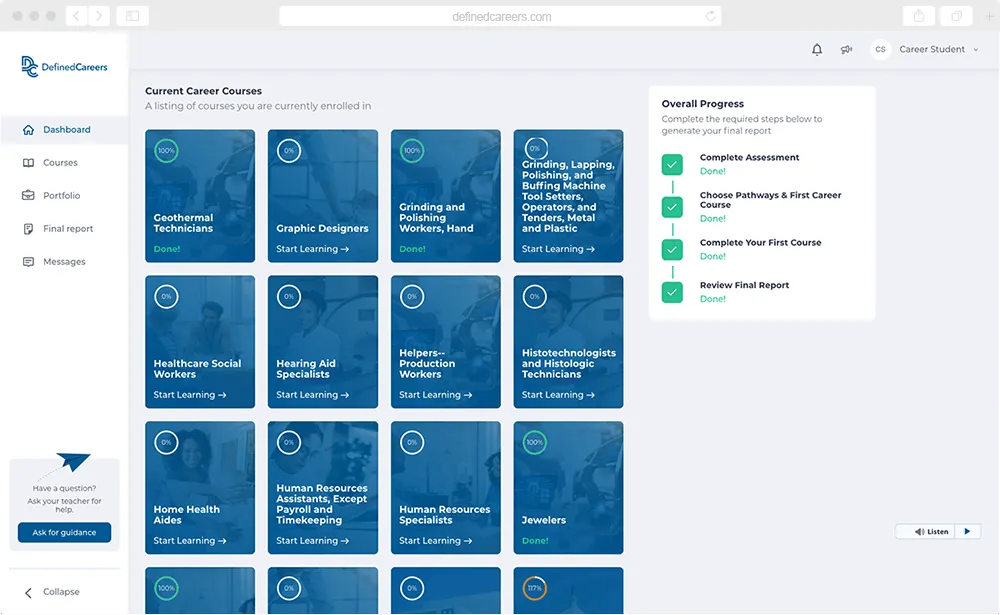
Because reporting matters so much, data is stored in a clean, structured way. This lets teams add new dashboards without rebuilding the core. In practice, this means the same engine can serve a small school and a whole state. Defined Careers proves that careful planning of data and roles is as important as any single feature.
Neutopia, Australia — Custom LMS Supporting Personalized Learning Journeys
Neutopia focuses on personalised learning paths and AI-driven suggestions inside a custom LMS. The goal is to give each learner a route that fits their pace, interests and language. This is different from a fixed course list. People can follow creators, topics or full programs over time.
Artificial intelligence here means software that looks at what a person reads, watches and finishes. It then suggests the next step, like a new resource or small task. These smart hints help build a smoother learning experience without extra work for tutors. The system learns which patterns work well and which ones need change.
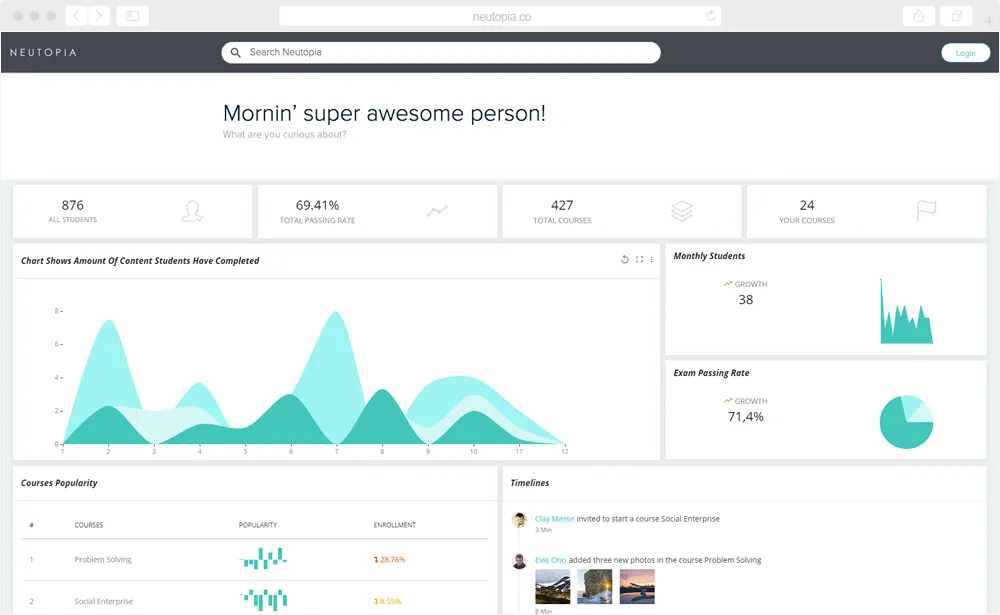
The custom functionality also supports blended learning. Learners can mix online work with live sessions and local events. They can use the platform in multiple languages and on different devices. This makes it easier for global teams and universities to serve mixed groups in one place. Content owners can still organise learning materials in clear paths and bundles.
For schools and companies, the benefit is flexible control. They can design programs for staff, students or customer groups without starting from zero each time. Progress data and feedback then shape the next version of each path. Neutopia shows how artificial intelligence and human design can work together in one custom LMS. It is a practical example of how personalisation can stay simple for end users.
Summing Things Up: A Complete Guide to How to Create a Learning Management System That Scales
This complete guide shows that how to create a learning management system that scales is a step-by-step job, not a one-off idea. Success comes from clear goals, a simple first version and a calm, repeatable process. When you see all parts together, your lms project stops being a vague plan and turns into a practical roadmap. You can then compare building your own learning management system with using a ready SaaS LMS in a fair way.
Everything starts with your business goals. You define what must change in training, what success looks like and who will use the system. Then you pick the deployment model, scope and budget for your lms solution. A scalable LMS solution comes from boring discipline, not magic features: clear goals, lean MVP, stable tech stack, steady delivery and honest feedback loops. In my experience, teams that do this early mitigate risks later, when real users log in at scale.
Next comes design of features and the development process. You set core features, plan the tech stack and agree how development teams, designers and QA engineers will work together. Strong process and a stable tech stack shorten development time and make changes less painful. Recommended tools for LMS development include no-code platforms like Knack, custom frameworks like React and Node.js, and pre-built LMS solutions like Absorb LMS and Canvas LMS. This is how you keep control of cost while you grow from minimum viable product to a more advanced platform. It also keeps room for future ideas such as AI or new types of learning materials.
In the end, an own learning management system is not only a set of screens. It is a long-term asset that supports training, corporate learning and customer training across many cycles of change. When your LMS project lines up with business goals and uses a stable process, it becomes a real competitive advantage, not just another tool. That is the core message of this complete guide on how to create a learning management system that can grow with your organisation.
A custom LMS makes sense when your workflows, roles, reporting or integrations do not fit any SaaS tool. It is also the right choice when learning becomes a core part of your product or competitive advantage.
###
Start with a focused MVP that covers user management, courses, reporting and one or two critical flows. This keeps risk low and helps you validate real learning behaviour before adding advanced features.
You control cost by setting clear business goals, limiting scope, and using a steady development process with QA. Clean data and a stable tech stack prevent expensive rework later.
A basic MVP usually takes a few months depending on scope and integrations. Full platforms grow over time in cycles, guided by learning data and user feedback.
Yes, if architecture, database structure and hosting are planned for scale from day one. Case studies like Defined Careers show that a well-designed LMS can support millions of learners.
Look for teams with real LMS or EdTech experience, transparent processes and clear communication. Talking with developers, QA engineers and analysts helps you see how they handle risk, quality and growth.



